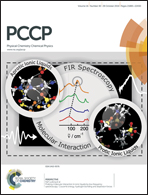Evolution of oxidation dynamics of histidine: non-reactivity in the gas phase, peroxides in hydrated clusters, and pH dependence in solution†
Abstract
Oxidation of histidine by 1O2 is an important process associated with oxidative damage to proteins during aging, diseases and photodynamic therapy of tumors and jaundice, and photochemical transformations of biological species in the troposphere. However, the oxidation mechanisms and products of histidine differ dramatically in these related environments which range from the gas phase through aerosols to aqueous solution. Herein we report a parallel gas- and solution-phase study on the 1O2 oxidation of histidine, aimed at evaluating the evolution of histidine oxidation pathways in different media and at different ionization states. We first investigated the oxidation of protonated and deprotonated histidine ions and the same systems hydrated with explicit water molecules in the gas phase, using guided-ion-beam-scattering mass spectrometry. Reaction coordinates and potential energy surfaces for these systems were established on the basis of density functional theory calculations, Rice–Ramsperger–Kassel–Marcus modeling and direct dynamics simulations. Subsequently we tracked the oxidation process of histidine in aqueous solution under different pH conditions, using on-line UV-Vis spectroscopy and electrospray mass spectrometry monitoring systems. The results show that two different routes contribute to the oxidation of histidine depending on its ionization states. In each mechanism hydration is essential to suppressing the otherwise predominant dissociation of reaction intermediates back to reactants. The oxidation of deprotonated histidine in the gas phase involves the formation of 2,4-endoperoxide and 2-hydroperoxide of imidazole. These intermediates evolve to hydrated imidazolone in solution, and the latter either undergoes ring-closure to 6α-hydoxy-2-oxo-octahydro-pyrrolo[2,3-d]imidazole-5-carboxylate or cross-links with another histidine to form a dimeric product. In contrast, the oxidation of protonated histidine is mediated by 2,5-endoperoxide and 5-hydroperoxide, which convert to stable hydrated imidazolone end-product in solution. The contrasting mechanisms and reaction efficiencies of protonated vs. deprotonated histidine, which lead to pH dependence in the photooxidation of histidine, are interpreted in terms of the chemistry of imidazole with 1O2. The biological implications of the results are also discussed.


 Please wait while we load your content...
Please wait while we load your content...